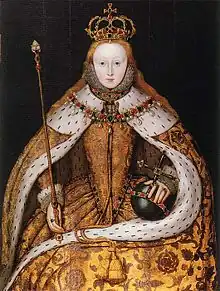Venetian ceruse

Venetian ceruse, also known as blanc de ceruse de Venise[2] and Spirits of Saturn,[3] was a 16th-century cosmetic used as a skin whitener. It was in great demand and considered the best available at that time. It is similar to the regular ceruse, although it was marketed as better, more exclusive and expensive than the regular ceruse variant.[4] The regular ceruse white pigment is a basic lead carbonate of chemical formula 2 PbCO
3·Pb(OH)
2 while the mineral cerussite is a simple carbonate of lead (PbCO
3).
A recipe from 1688 described the cosmetic as a mixture of water, vinegar, and lead.[4] The cosmetic's use of white lead as a pigment caused lead poisoning, damaging the skin and causing hair loss. Usage over an extended period could cause death.[3]
Users
Some sources state that Elizabeth I of England used Venetian ceruse,[lower-alpha 1] and some state that she may have used Venetian ceruse.[1] Critics such as Anna Riehl[6] and Kate Maltby[7] have argued that little historical evidence exists to support the claim that Elizabeth used ceruse.
Ceruse was also blamed for the death of Maria Coventry, Countess of Coventry, aged 27, in 1760. Coventry had been a frequent user of ceruse, and is believed to have died of lead poisoning.[3][8]
Another devout user of the cosmetic was Isabella d'Este; her appearance demonstrated how ceruse caused permanent damage and premature aging. In 1534, an account by Pietro Aretino described her "smeared face" as "dishonestly ugly and even more dishonestly made up."[9]
Notes
References
- 1 2 Thomas, L.M. (2020). Beneath the Surface: A Transnational History of Skin Lighteners. Theory in Forms. Duke University Press. p. pt26. ISBN 978-1-4780-0705-0. Retrieved 2020-07-17.
- ↑ Nicholas Eastaugh; Valentine Walsh; Tracey Chaplin; Ruth Siddall (2007). Pigment Compendium: A Dictionary of Historical Pigments. Burlington, MA: Elsevier Butterworth-Heinemann. p. 44. ISBN 9781136373855.
- 1 2 3 Kassia St. Clair (2016). The Secret Lives of Colour. London: John Murray. p. 45–46. ISBN 9781473630819. OCLC 936144129.
- 1 2 Lisa Eldridge (2015). Face Paint: The Story of Makeup. Abrams. ISBN 9781613128183.
- ↑ Snodgrass, M.E. (2015). World Clothing and Fashion: An Encyclopedia of History, Culture, and Social Influence. Taylor & Francis. p. 154. ISBN 978-1-317-45167-9. Retrieved 2020-07-17.
- ↑ Anna Riehl (2010). The Face of Queenship: Early Modern Representations of Elizabeth I. ISBN 9780230106741.
- ↑ "Why is Elizabeth I always depicted as a grotesque?". Kate Maltby. 2015-05-25. Retrieved 2019-10-05.
Even Venetian Ceruse, the notorious pale make-up used by Elizabethan actors and never found in the inventories of the queen herself, has been shown in reconstructions to blend lightly into the skin like a modern concealer...
- ↑ Susan Stewart (2017). Painted Faces: A Colourful History of Cosmetics. Amberley Publishing. ISBN 9781445654003.
- ↑ Jill Condra (2008). The Greenwood Encyclopedia of Clothing Through World History. Westport, CT: Greenwood Publishing Group. p. 35. ISBN 9780313336621.